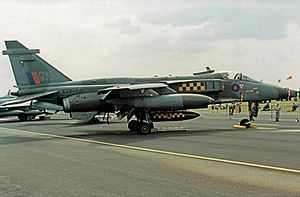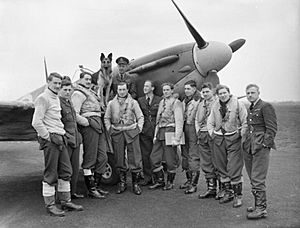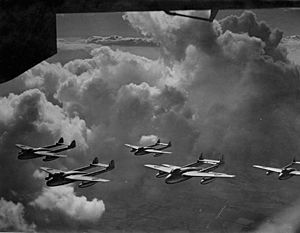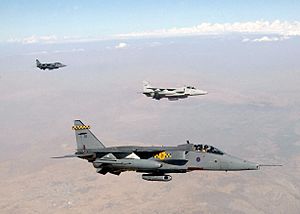No. 54 Squadron RAF facts for kids
Quick facts for kids No. 54 Squadron RAF |
|
|---|---|

Squadron badge
|
|
| Active | 5 May 1916 – 1 April 1918 (RFC) 1 April 1918 – 25 October 1919 (RAF) 15 January 1930 – 31 October 1945 15 November 1946 – 11 March 2005 1 September 2005 – present |
| Country | |
| Branch | |
| Type | Flying squadron |
| Role | Intelligence, Surveillance, Target Acquisition and Reconnaissance (ISTAR) Operational Conversion Unit |
| Part of | No. 1 Group |
| Home station | RAF Waddington |
| Motto(s) | Audax omnia perpeti (Latin for 'Boldness endures anything') |
| Aircraft |
|
| Battle honours |
|
| Insignia | |
| Squadron badge | Lion rampant semée de lys. The badge combines features of the arms of France and Flanders, commemorating the squadron's battles on the Western Front during the First World War. Approved by King George VI. |
| Squadron roundel |  |
| Squadron codes | DL (Apr 1939 – Sep 1939, Apr 1944 – Oct 1945) KL (Sep 1939 – Jun 1942) HF (Nov 1945 – Apr 1948) (Codes taken over from No. 183 Sqn) GA–GZ (Jaguars) |
No. 54 Squadron (also known as No. LIV Squadron) is a special flying unit of the Royal Air Force (RAF). It is based at RAF Waddington in Lincolnshire, UK. Since 2005, its main job has been to train RAF crews for important spy and observation missions.
Today, No. 54 Squadron is known as the Advanced Air ISTAR Academy. ISTAR stands for Intelligence, Surveillance, Target Acquisition, and Reconnaissance. This means they train people to gather information, watch over areas, find targets, and explore. They teach crews to fly aircraft like the MQ-9A Reaper drones, Protector RG1, Shadow R1/R2, RC-135W Rivet Joint, and Poseidon MRA1. They also run special courses for expert instructors in this field.
Before 2005, the squadron flew SEPECAT Jaguar fighter jets. They were based at RAF Coltishall in Norfolk until the unit was closed down on March 11, 2005.
Contents
History of No. 54 Squadron
Early Years and World War I
No. 54 Squadron started on May 5, 1916, at Castle Bromwich. At first, they protected the UK skies with BE2Cs and Avro 504 planes. A few months later, they got Sopwith Pup planes. They were the first Royal Flying Corps squadron to use the Pup.
In December 1916, they moved to France as a fighter squadron. They helped protect bombers and shot down their first enemy plane, an Albatros D.III, in April 1917. They became very good at attacking enemy observation balloons during the Battle of Arras.
As the war went on, the Sopwith Pup became less effective in air fights. So, No. 54 Squadron focused on attacking targets on the ground. In December 1917, they got new Sopwith Camel planes. This allowed them to return to fighter duties, protecting other RAF planes. During the German spring offensive, they again flew low-level ground attack missions. The squadron was disbanded in October 1919 after the war ended.
Between the World Wars
The squadron was restarted on January 15, 1930, at RAF Hornchurch. They first used Siskin training planes. Soon after, they received Bristol Bulldog fighter planes in April 1930.
Over the years, they upgraded their aircraft. They flew Gauntlets from 1936 and Gladiators from 1937. In March 1939, they received their first modern monoplane, the famous Supermarine Spitfire.
World War II and the Battle of Britain
When World War II began, No. 54 Squadron patrolled the coast of Kent. In May 1940, they helped protect the ships during the evacuation of Dunkirk. They claimed to have shot down 31 enemy aircraft during this time.
From July 1940, the squadron was heavily involved in the Battle of Britain. This was a major air battle over the UK. The fighting was very tough, and the squadron suffered many losses. They were moved away from the intense fighting in September 1940. One famous pilot, "Al" Deere, shot down 11 German planes. He was also shot down 7 times himself!
In February 1941, No. 54 Squadron returned to Hornchurch. They flew missions over Northern France, attacking enemy planes and protecting bombers. In November 1941, they moved to RAF Castletown in Scotland to patrol the coast.
Service in Australia
In mid-1942, the squadron prepared to move to Australia. They joined the Royal Australian Air Force's (RAAF) No. 1 Wing. This unit used Spitfires to defend against Japanese aircraft near Darwin.
No. 54 Squadron arrived in Darwin in January 1943. Their pilots were new to the area, and their Spitfires had some mechanical issues from shipping. Despite this, they managed to shoot down several Japanese planes. After the war ended, the squadron was disbanded in Melbourne on October 31, 1945.
After World War II
On November 15, 1945, a different squadron, No. 183 Squadron, was renamed No. 54 Squadron. They trained pilots for overseas service. They then received Vampire jet planes and moved to RAF Odiham in November 1947.
In 1948, six Vampire jets from the squadron made history. They were the first jet aircraft to fly across the Atlantic Ocean! They flew in three stages, taking over eight hours in the air.
After flying Meteors for three years, they received Hunters in March 1955. The squadron became part of No. 38 Group, often flying to different parts of the world where there were problems. No. 54 Squadron was also the first RAF jet team to use smoke trails during air shows.

In 1955, No. 54 Squadron formed an aerobatic team with four Hawker Hunter F1 aircraft. The next year, this team was called The Black Knights. The pilots even wore black flying suits! They later upgraded to Hunter Mk9s and moved bases several times.
The squadron was briefly closed down on September 1, 1969, but reformed on the same day. They were re-equipped with McDonnell-Douglas Phantom jets at RAF Coningsby.
The Jaguar Era and Beyond

By 1974, the squadron had moved to RAF Coltishall and received twelve SEPECAT Jaguar aircraft. For many years, their job was to support ground forces in Europe. They could use both regular weapons and, if needed, tactical nuclear bombs. This was during the Cold War, when tensions were high.
After the Cold War ended and nuclear weapons were retired, the squadron took on new roles. They were sent on missions to places like Northern Iraq and the Balkans. As the RAF planned to replace the Jaguar jets with the new Typhoon, No. 54 Squadron was closed down again on March 11, 2005.
Modern Role: Training for ISTAR
On September 1, 2005, No. 54 Squadron was reformed as No. 54 (Reserve) Squadron at RAF Waddington. Its new role was to train crews for Intelligence, Surveillance, and Reconnaissance (ISR) missions. They trained crews for aircraft like the E-3D Sentry, Nimrod R1, Sentinel R.1, Shadow R1, and later the MQ-9A Reaper drone.
Since 2010, the squadron has been home to the ISR Warfare School. This school teaches the Qualified Weapons Instructor (QWI) course for ISR. In 2013, they also started training crews for the new RC-135 Rivet Joint aircraft. The "Reserve" part of their name was removed in 2018.
In October 2019, crews from No. 54 Squadron flew the first RAF Boeing Poseidon MRA.1 aircraft from Seattle to Florida. Since October 2020, they have a team at RAF Lossiemouth in Scotland to train Poseidon MRA.1 crews.
Advanced Air ISTAR Academy
In June 2021, the Defence Secretary announced that No. 54 Squadron would become the new Advanced Air ISTAR Academy. This means it's a top center for training in remotely piloted aircraft and intelligence gathering. The squadron continues to train crews for the RAF ISTAR Force.
In May 2023, No. 54 Squadron began training crews for the Protector RG1 drone. They work with the manufacturer, General Atomics, at Grand Forks Air Force Base in North Dakota, USA.
Locations of No. 54 Squadron
Over its history, No. 54 Squadron has been based at many different airfields. Here are some of the main ones:
Locations in Britain
- RAF Hornchurch, Essex (September 1939, February 1941)
- RAF Catterick, North Yorkshire (September 1940)
- RAF Castletown, Scotland (November 1941)
- RAF Wellingore, Lincolnshire (June 1942)
Locations in Australia
- Ascot Vale, Melbourne, Victoria (August 1942)
- Richmond, Sydney, New South Wales (August 1942)
- Parap Airfield, Darwin, Northern Territory (January 1943, October 1945)
- Potshot, Exmouth Gulf, Western Australia (May 1944)
- Livingstone Airfield, Northern Territory (May 1944)
- Melbourne, Victoria (October 1945)
Aircraft Flown by No. 54 Squadron
No. 54 Squadron has flown many different types of aircraft throughout its history. Here are some of them:
- Royal Aircraft Factory B.E.2c (1916)
- Royal Aircraft Factory B.E.12 (1916)
- Avro 504 (1916)
- Bristol Scout (1916)
- Sopwith Pup (1916–1917)
- Sopwith Camel (1917–1919)
- Armstrong Whitworth Siskin Mk.IIIa/Mk.IIIdc (1930)
- Bristol Bulldog Mk.IIa (1930–1936)
- Gloster Gauntlet Mk.II (1936–1937)
- Gloster Gladiator Mk.I (1937–1941)
- Supermarine Spitfire Mk.I (1939–1941)
- Supermarine Spitfire Mk.IIa (1941)
- Supermarine Spitfire Mk.Va (1941)
- Supermarine Spitfire Mk.IIb (1941–1942)
- Supermarine Spitfire Mk.Vb (1942)
- Supermarine Spitfire Mk.Vc (1942–1944)
- Supermarine Spitfire Mk.VIII (1944–1945)
- Hawker Tempest Mk.II (1945–1946)
- de Havilland Vampire Mk.I (1946–1948)
- de Havilland Vampire F.3 (1948–1949)
- de Havilland Vampire FB.5 (1949–1952)
- Gloster Meteor F.8 (1952–1955)
- Hawker Hunter F.1 (1955)
- Hawker Hunter F.4 (1955–1957)
- Hawker Hunter F.6 (1957–1960)
- Hawker Hunter FGA.9 (1960–1969)
- McDonnell Douglas Phantom FGR.2 (1969–1974)
- SEPECAT Jaguar GR.1 (1974–1999)
- SEPECAT Jaguar GR.3 (1999–2005)
- Boeing E-3D Sentry AEW.1 (2005–2021)
- Hawker Siddeley Nimrod R.1 (2005–2011)
- Raytheon Sentinel R.1 (2008–2021)
- Beechcraft Shadow R.1 (2009–present)
- Boeing RC-135W Airseeker R.1 (2011–present)
- General Atomics MQ-9A Reaper (present)
- Boeing Poseidon MRA.1 (2019–present)
- Protector RG1 (2023–present)
See also
Former RAF Jaguar units
- II(AC) Sqn
- 6 Sqn
- 14 Sqn
- 16(R) Sqn – OCU
- 17 Sqn
- 20 Sqn
- 31 Sqn
- 41 Sqn
- No. 226 Operational Conversion Unit RAF
- List of Royal Air Force aircraft squadrons




